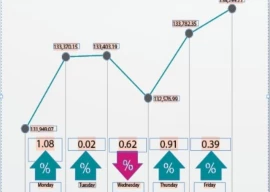
Given the volatility in financial markets, we must not underestimate the power of portfolio management. Similarly, it is equally valid to note that no hospital wings or college corridors have been named after well-diversified investors.
So, what steps should one take to develop a winning investment portfolio? The foundation to build an investment portfolio has to be on two main components – acceptable risk and asset allocation.
There’s no telling what sort of flux economies and investment markets will be in tomorrow, that is why one must focus on building a solid investment portfolio. Good news is that via smart asset allocation, some investment risks, specifically unsystematic risk (the risk that lies within one particular investment) can be diversified.
As one gains expertise within the investment arena and improves the skill of identifying stocks, the portfolio can focus on a limited few stocks.
Asset allocation can be made by choosing from a range of investments across different asset classes like mutual funds, bonds, foreign currency, commodities, real estate and insurance (bancassurance or otherwise).
Stocks, real estate and commodity investments do well in times of economic prosperity while fixed-income products (bonds) and precious metals fare well in times of economic slowdown.
One of the most ignored areas within the domain of investment has been protection and retirement planning. Apart from traditional investments, it is highly recommended that an individual give due importance to insurance solutions, which typically offer defined returns after a certain date or post-certain untoward event.
Ensuring the right mix of these assets within the portfolio helps attain the targeted risk-reward ratio.
Risk tolerance
Every person has a unique level of risk tolerance, which varies with age, income and financial goals.
A high-risk investor would be willing to expose himself to a potential loss of up to 35-50% of the portfolio in order to maximise potential gains whereas for some safe investors the ‘return of capital’ is more important than the ‘return on capital’.
Most people in order to protect their savings park them in bank deposits to enjoy low-risk returns. However, this may not be the ideal way of managing the portfolio risk when inflation is factored in.
Depending on the individual’s needs, age and life cycle, risk can be contained at the desirable level via an assortment and diverse mix of investment products.
Now let’s imagine a young enthusiastic investor in his 20s, based on his life cycle, would most probably have the willingness/ability to withstand large swings in the value of his investment.
On the flip side, picture a mom with kids in teens, with upcoming educational responsibilities, safety of the capital would be the top priority.
While there is no perfect way of knowing one’s perfect risk acceptability, many methods can be used to help reach a fair estimate. These include online questionnaires designed to reveal the level at which an investor can invest and lose, but still be able to sleep peacefully at night.
Take Pakistan Stock Exchange (PSX) as an example. The bourse has posted a significant growth in the past decade of about 315%, which translates into annual return of 12%.
In 2019, the performance remained muted owing to political uncertainty. However, some sectors still offer attractive valuations and upgraded earnings, supported by moderate GDP growth forecast of 2.2% in FY20.
Capital value
In the current scenario of interest rate near its peak and high inflation, Pakistani investors will struggle to preserve the value of their capital. Thus, taking exposure in the equity market with the help of a professional fund/wealth manager might be a good idea to start with.
In investing, the biggest challenge is to develop a strategic asset allocation mix. Investment researchers worldwide suggest that the choice of capital allocation to different asset classes is one of the key determinants of investment returns.
An aggressive asset allocation strategy may invest 75% in equity funds, 15% in insurance and 10% in bonds.
Understanding how the assets interact and react to changes in the economy and other external events is very important. Building a portfolio with lower correlation between holdings is the key to ensuring a level of diversification, which matches the risk return profile of the investor.
Markets have been and will always remain volatile and no one knows what the future holds, so a well-diversified portfolio will generate better risk-adjusted returns and is the best defence in times of economic uncertainty.
The writer is a seasoned treasury and wealth management banker and a visiting faculty at IBA
Published in The Express Tribune, February 10th, 2020.
Like Business on Facebook, follow @TribuneBiz on Twitter to stay informed and join in the conversation.


















COMMENTS
Comments are moderated and generally will be posted if they are on-topic and not abusive.
For more information, please see our Comments FAQ